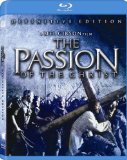| Reviews & Columns |
|
Reviews DVD TV on DVD Blu-ray 4K UHD International DVDs In Theaters Reviews by Studio Video Games Features Collector Series DVDs Easter Egg Database Interviews DVD Talk Radio Feature Articles Columns Anime Talk DVD Savant Horror DVDs The M.O.D. Squad Art House HD Talk Silent DVD
|
DVD Talk Forum |
|
|
| Resources |
|
DVD Price Search Customer Service #'s RCE Info Links |
|
Columns
|
|
|
Passion of the Christ: Definitive Edition, The
Fox // R // February 17, 2009
List Price: $34.98 [Buy now and save at Amazon]
The Film:
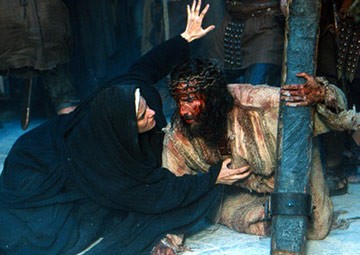 There's a great little arthouse theater in Atlanta -- the Lefont Plaza on Ponce -- where I first saw Mel Gibson's The Passion of the Christ. In the modest, dark little auditorium accented by taupe fabrics and kitschy vintage architecture, the audience sat back to revel in a picture that was receiving both scathing and favorable comments about its entrancing, violent depiction of "the greatest story ever told", as well as to watch Gibson's potentially "anti-Semitic" tone. Is Christ historically real, is Christ a figment of believers' imagination, is Christ the embodiment of God himself ... all of these theological ideas collided amid this picture, all to witness a portrayal that tries to translate a fantastical parable into a realistic portrait. Christians, Agnostics, and other sorts of both faith-based and realist moviegoers saw the film, and they all came away with a surprisingly consistent impression: "Man, that was bloody".
There's a great little arthouse theater in Atlanta -- the Lefont Plaza on Ponce -- where I first saw Mel Gibson's The Passion of the Christ. In the modest, dark little auditorium accented by taupe fabrics and kitschy vintage architecture, the audience sat back to revel in a picture that was receiving both scathing and favorable comments about its entrancing, violent depiction of "the greatest story ever told", as well as to watch Gibson's potentially "anti-Semitic" tone. Is Christ historically real, is Christ a figment of believers' imagination, is Christ the embodiment of God himself ... all of these theological ideas collided amid this picture, all to witness a portrayal that tries to translate a fantastical parable into a realistic portrait. Christians, Agnostics, and other sorts of both faith-based and realist moviegoers saw the film, and they all came away with a surprisingly consistent impression: "Man, that was bloody".
In a strange fashion, that's exactly the kind of singular focus Mel Gibson wants to achieve on The Passion of the Christ's surface: through a grueling, treacherous crawl through the "stations" of the cross in ultra-realistic fashion (all the way to the subtitled Aramaic language), he shows his audience what this seemingly-historical figure suffered through in the name of love, humanity, and unswerving belief. It captures the torture and crucifixion of Jesus Christ, a carpenter-turned-cleric who believes that he's the son of God, all framed within the events occurring in last few days of his life. Gibson shows us the fabric of his many loving relationships through a flashback-style broken narrative, introducing us to his followers and family -- most prominently Mary Magdalen (Monica Bellucci) and his mother Mary (Maia Morgenstern) -- while illustrating some of the keynote elements of his belief structure. He's seen washing his believer's feet and breaking bread with his disciples, all spliced in between blood-drenched images of his prosecution due to charges of blasphemy. Jesus believes that the blood of God courses through him to a degree that allows him to work true miracles, while the Jewish priests believe this to be heresy. As most of the common world knows, this results in a witch hunt that would lead to public ridicule and, ultimately, a heretic-style reprimand.
One of my concerns before stepping into The Passion of the Christ was whether Gibson would portray these metaphysical elements -- Christ's healing properties, the presence of Satan, etc. -- in a way that would alienate those who hold alternate ideals about their nature (some believe his powers are literal, others metaphorical). He integrates careful usage of this in seamless fashion with the narrative, while rarely emphasizing whether these are physical manifestations or maddened delusions. Usage of the devil, played magnificently by female actress Rosalinda Celentano, is especially potent; in Jesus' fraught moments in the garden of Gethsemane, he/she gazes upon him with piercing eyes as she coaxes him with language about supporting the burdens of humanity's sin. It's a terrifying scene, one that illustrates the biggest glimpse of uncertainty and fear in Jesus' prophetic stature. Satan makes several other appearances, but Gibson carefully uses him/her as a snake-like, invisible entity that interacts with Jesus. Judas (Luca Lionello), the man who sold Jesus' location to the riotous zealots for money, also sees demon children, but only after he plummets into a harrowing mental state that could create frightening manifestations.
Now, there is an instance of his miraculously healing power as he fuses an ear back onto a man's bleeding head, which happens to be the only non-avoidable example of "magic" in Gibson's film -- and an evident link broken between realist-conceived Jesus and Christianity-conceived Jesus. This subtle gesture is a precise move on Gibson's part; he expresses his own personal belief at the start, gets it out of the way, and allows the rest of Jesus' brutal crucifixion to unfold as an unswerving message of endurance and faith, one that could exist as the trails and tribulations of the true son of God or the glorified martyrdom of a love-crazed believer. The Passion of the Christ tries its hardest to cater to both pragmatists and devout believers alike, and it does so in an involving and breathtaking way that emphasizes a man's relentless drive to stay true to his place on this earth.
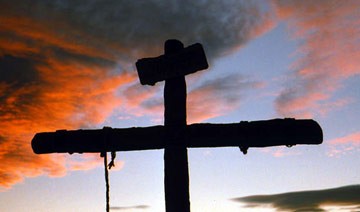 Gibson's storytelling rhetoric thrives off of vividness in The Passion of the Christ, as he wishes to drag us through all the brutality to emphasize exactly what Jesus endured for humanity. With all the spilled blood, the devolved ridicule from the Roman strong-arms, and the painful groans and quaking bodily gestures pouring from Caviezel's Jesus, it's excruciating to watch -- and successfully mesmerizing. In Braveheart, Gibson trails our vision away from witnessing the torturous acts conducted near the film's conclusion. Here, it's antithetic to his Oscar-winning film: operating on a small-ish $30m budget didn't seem to have any effect on his astonishingly realistic production, because he only shies away from brutality once he's intentionally soared way over the top to hammer his message home. Capturing the physical crucifixion itself was brutal enough, but it's the process leading up until this point that earns The Passion of the Christ its stigma.
Gibson's storytelling rhetoric thrives off of vividness in The Passion of the Christ, as he wishes to drag us through all the brutality to emphasize exactly what Jesus endured for humanity. With all the spilled blood, the devolved ridicule from the Roman strong-arms, and the painful groans and quaking bodily gestures pouring from Caviezel's Jesus, it's excruciating to watch -- and successfully mesmerizing. In Braveheart, Gibson trails our vision away from witnessing the torturous acts conducted near the film's conclusion. Here, it's antithetic to his Oscar-winning film: operating on a small-ish $30m budget didn't seem to have any effect on his astonishingly realistic production, because he only shies away from brutality once he's intentionally soared way over the top to hammer his message home. Capturing the physical crucifixion itself was brutal enough, but it's the process leading up until this point that earns The Passion of the Christ its stigma.
Namely the scourging, which is a scene that deeply -- deeply -- affected me in the theater. While it's true that the crucifixion and the placement of his crown of thorns are both brutal and realistically-achieved by way of amazing make-up and production work, his relentless whipping is the coup de grace. Gibson uses this as a pivotal moment in Christ's test of fortitude, as well as an opportunity to illustrate the animal-like brutality imposed on him by misguided hands. He does so in painstaking fashion, fusing together the Oscar-nominated make-up work and Jim Caviezel's astounding performance as Jesus to give this scene weight. Is it as gruesome and disheartening as it's made out to be by relentless media pandering? At its most aggressive moments, it sure is -- especially this scene which, once the weapons shift from sticks to the snaggle-tooth Roman scourge, gets very, very graphic.
After a controversial papal endorsement for this striking depiction -- amounting to a statement saying "it is as it was" -- and recognition from award circuits for its phenomenal cinematography and musical accompaniment, what's left years after The Passion of the Christ's release is a seasoned and skillful director's evocative portrait that teeters dangerously close to existing in the horror genre. Consider this: torture cinema aims to make the audience squirm and shiver, which is the direction that Mel Gibson goes -- but with different motives other than to just purely disturb, though that's certainly one of his goals. He doesn't try and divert to what-ifs like Scorsese's adaptation of The Last Temptation of Christ or to Biblical postcard cinema like The Greatest Story Ever Told, but instead goes his own route by producing something that taps into the darker corners of inherent human solace by thrusting gratuity in our face. It's simple and unpleasant in purpose, but the literature and allegorical nature of the figure all swirl around its simple nature enough to make sure it isn't just a pure surface-level bloodbath of the world's more renowned religious figure. The Passion of the Christ swells to an experience larger than its Christian focus, instead becoming a potent human depiction that becomes accessible and hard-edged in the same breath.
The Blu-ray:
Video and Audio:
From the darkened moments in the garden to the massive walled-in architecture backdropping Jesus' trek to the crucifixion point, The Passion of the Christ looks extremely good in preserving the film's 2.40:1 negative in a sharp 1080p AVC encode. Detail operates as the crowning achievement in this transfer, as the sandy textures and ornate costume design all leap from the screen. Contrast levels display inky shadows and natural mid-tones, especially noticeable during the fire-lit nighttime sequences. Generally, the muted color palette shows off a pleasant gradient of tans and other dark varietals as well.
One troubling issue crops up with skin tone, however; now, I vaguely remember flesh tone being a bit on the pink-ish side in the theater, but nowhere near this hot. At times, they appear natural to the color scheme, while others step way too far over into blistering shades. No matter if it's Gibson's intent or not, the blistering rosy shades are too distracting in spots. Still, there are other scenes where facial tones and detail come across as perfectly natural and aptly displayed -- while staying distortion and edge-enhancement free. It's a stark, well-defined transfer from Fox that stands strong against a few nit-picky hiccups. The Passion of the Christ's lustrous DTS HD Master Audio track helps to thicken the atmosphere with surprising breadth, creating a sound design that's both expansive and delicate. It captures the natural mode of the setting surprisingly well, keeping the dusty echoes and environmental eccentricities very immersive. The range of sound effects all leap from the soundstage; from the crowd's jeering to the cringe-worthy lashes against Jesus' back, it never steps away form giving the film's sound plenty of tangibility. Surprisingly, the lower-frequency track get a workout as well, hitting both mid-range and deep quadrants as Jesus exhaustively drops the cross and falls repeatedly along the way to the crucifixion site. Dialogue never has to fight with the musical accompaniment for audibility, but the way John Debney's heart-pounding score sound here really sells the experience. Multi-dimensional, expansive, and boisterous, this is an immensely satisfying Master Audio track for an intricately-designed sound experience. Subtitles are available in Korean, Cantonese, Mandarin, Spanish, Thai, and English SDH to accompany the Aramaic track.
Special Features:
On the Blu-ray Disc itself, we've got four (!) Commentaries -- one with the filmmakers, one with the producers, one with theologians, and one (segmented) with the musical composer -- that give you just about every ounce of supplemental material that you could possibly want about the film's build quality and assembly. Gibson/Deschanel/Wright's commentary stays informative, though it takes an odd tone in being a more casual and chuckle-worthy filmmaker's discussion. The Producer's Commentary, however, is extremely smooth and informative, staying in pseudo-commoner speech as they discuss visual effects, make-up design, and other random anecdotes about shooting the film. Probably the best commentary, however, is the Theological Commentary, which gets Mel Gibson in the midst of religious experts as they discuss the symbolism, the potency, and the messages scattered throughout the film as they interconnect with the narrative of Christ. Don't let the fact that it's a "religion" commentary steer you away from it -- if that doesn't compel you -- because the symbolism that they discuss also pertains to Gibson's filmmaking techniques to convey messages.
Also available on this disc is the Passion: Recut version of the film which removes around 5 minutes of brutality form the picture, as well as a series of Footnotes that reference to the Biblical verses and historical accounts that the film's events use for quotations and "accuracy".
On the Standard Definition Disc Two, the material is separated into three portions: Filmmaking, The Legacy, and Galleries. Most of the special features are full-frame presentations, while a select few -- trailers and such -- have been enhanced for widescreen televisions. Most of them are fascinating, while others can grow to be a little repetitive as the features press forward. One factors is cleanly evident: these exasperating special features place heavy emphasis on this edition of The Passion of the Christ as the unequivocal "Definitive Edition".
In the Filmmaking portion, the key feature is the huge By His Wounds, We Are Healed: Making of The Passion of the Christ (1:40:16, FF) which follows just about every imaginable tangent, production element, and motivation behind Gibson's feature. The director is featured prominently through interview time and conversation during his shoots, giving anecdotes about script building, the accuracy of the production design and language, and his acting choices. It's exhaustive, but thankfully the feature has been segmented into twenty-one (21) chapters to allow for broken-up viewing times. Also in this section is an intriguing Panel Discussion (13:50, FF) that covers a Q&A on the production design. Finally, two Deleted Scenes (~4:30) are included.
In the Legacy portion, the history and symbolic representation of Jesus Christ are covered in a series of analytical featurettes. Through The Ages (11:57, FF) gives an study that bridges the gaps between art and religion, emphasized by art experts who take specific works and dive into the "symbiotic relationship" between the two. Some of the film's historical accuracy falls under focus in Paths of a Journey (9:24, FF), which gives a highly elaborative pathway through the "stations". It also connects them to their occurrences in the Bible, giving some historical insight into this trek. On Language (12:45) is a very insightful featurette that covers Gibson's usage of Jesus' traditional Aramaic language instead of English or any others in the eyes of the language expert on the film, while also covering how delving into that language gives the verbose a certain flow that would otherwise be lost. They've also brought on crucifixion experts to elaborate on the symbolic form of torture in the film in Crucifixion: Punishment in the Ancient World (17:27, FF), delving into the roots of the word "excruciating" while discussing the science behind the ghastly act. Rounding out this portion is Anno Domani (10:03, FF), a reference featurette that illustrates what happens to the disciples following the death of Christ.
In the Galleries portion, we're given a slew of static images to sift through pertaining to the conceptualization of the film. Production Art covers the extensive Costume and Set Design, Technical Drawings, and Storyboards (for Garden of Olives, The Flogging, Crucifixion FX, and Raising the Cross) associated with the film, while the Art Images reference the historical pieces of artwork referenced by the filmmakers in constructing the mood and aesthetic for the stations of the cross (Station I -- XIV). Historical Texts basically translates to the Bible verses referenced in the film, presented in lengthy fashion through a series of static, skippable lines of text. Characters and their Actors covers the many entities in the film, while giving filmographies and histories behind each actor that portrayed them. Also available are a fantastic series of Unit Photography stills, which offer a gorgeous array of black-and-white shots that capture Gibson's filmmaking process splendidly. Finally, we've got a series of Trailers and TV Spots, which the Trailers have both been enhanced for widescreen televisions.
Final Thoughts:
Few films have left me in a visceral daze after watching them, but The Passion of the Christ is undoubtedly one of them. How a film containing so much brutality and mean-spirited energy surrounding its focal character can be this reverent is astonishing, as Mel Gibson gathers together his award-winning directorial chops to piece together a "simple" work of art heavily saturated with symbolism and belief-bending rhetoric. While it's true that Christians will certainly walk away more affected by this than those of other beliefs (or lack thereof), the sheer strength in Christ's struggle to endure all shades of pain for belief can be soaked in by just about everyone. Plus, Mel Gibson can certainly tell a story, which he does amid beautiful photography and sweeping music. It's painful to watch -- at times very painful -- but The Passion of the Christ's message of perseverance is worth the anguish.
Fox's Blu-ray presentation of this "Definitive Edition" offers a striking visual transfer and immersive DTS HD Master Audio track, both of which pump the film full of tactile breadth. But the star of this show is the incredible array of supplements, which soars well beyond the levels of standard, condensed material that we see in most home video presentations. Though the return value is difficult to judge based on the skin-curdling content of the flogging, ridicule, and crucifixion of Jesus, it's still a marvelous picture to behold that comes Highly Recommended in this stellar, cost-effective presentation from Fox.
Thomas Spurlin, Staff Reviewer -- DVDTalk Reviews | Personal Blog/Site
 There's a great little arthouse theater in Atlanta -- the Lefont Plaza on Ponce -- where I first saw Mel Gibson's The Passion of the Christ. In the modest, dark little auditorium accented by taupe fabrics and kitschy vintage architecture, the audience sat back to revel in a picture that was receiving both scathing and favorable comments about its entrancing, violent depiction of "the greatest story ever told", as well as to watch Gibson's potentially "anti-Semitic" tone. Is Christ historically real, is Christ a figment of believers' imagination, is Christ the embodiment of God himself ... all of these theological ideas collided amid this picture, all to witness a portrayal that tries to translate a fantastical parable into a realistic portrait. Christians, Agnostics, and other sorts of both faith-based and realist moviegoers saw the film, and they all came away with a surprisingly consistent impression: "Man, that was bloody".
There's a great little arthouse theater in Atlanta -- the Lefont Plaza on Ponce -- where I first saw Mel Gibson's The Passion of the Christ. In the modest, dark little auditorium accented by taupe fabrics and kitschy vintage architecture, the audience sat back to revel in a picture that was receiving both scathing and favorable comments about its entrancing, violent depiction of "the greatest story ever told", as well as to watch Gibson's potentially "anti-Semitic" tone. Is Christ historically real, is Christ a figment of believers' imagination, is Christ the embodiment of God himself ... all of these theological ideas collided amid this picture, all to witness a portrayal that tries to translate a fantastical parable into a realistic portrait. Christians, Agnostics, and other sorts of both faith-based and realist moviegoers saw the film, and they all came away with a surprisingly consistent impression: "Man, that was bloody". In a strange fashion, that's exactly the kind of singular focus Mel Gibson wants to achieve on The Passion of the Christ's surface: through a grueling, treacherous crawl through the "stations" of the cross in ultra-realistic fashion (all the way to the subtitled Aramaic language), he shows his audience what this seemingly-historical figure suffered through in the name of love, humanity, and unswerving belief. It captures the torture and crucifixion of Jesus Christ, a carpenter-turned-cleric who believes that he's the son of God, all framed within the events occurring in last few days of his life. Gibson shows us the fabric of his many loving relationships through a flashback-style broken narrative, introducing us to his followers and family -- most prominently Mary Magdalen (Monica Bellucci) and his mother Mary (Maia Morgenstern) -- while illustrating some of the keynote elements of his belief structure. He's seen washing his believer's feet and breaking bread with his disciples, all spliced in between blood-drenched images of his prosecution due to charges of blasphemy. Jesus believes that the blood of God courses through him to a degree that allows him to work true miracles, while the Jewish priests believe this to be heresy. As most of the common world knows, this results in a witch hunt that would lead to public ridicule and, ultimately, a heretic-style reprimand.
One of my concerns before stepping into The Passion of the Christ was whether Gibson would portray these metaphysical elements -- Christ's healing properties, the presence of Satan, etc. -- in a way that would alienate those who hold alternate ideals about their nature (some believe his powers are literal, others metaphorical). He integrates careful usage of this in seamless fashion with the narrative, while rarely emphasizing whether these are physical manifestations or maddened delusions. Usage of the devil, played magnificently by female actress Rosalinda Celentano, is especially potent; in Jesus' fraught moments in the garden of Gethsemane, he/she gazes upon him with piercing eyes as she coaxes him with language about supporting the burdens of humanity's sin. It's a terrifying scene, one that illustrates the biggest glimpse of uncertainty and fear in Jesus' prophetic stature. Satan makes several other appearances, but Gibson carefully uses him/her as a snake-like, invisible entity that interacts with Jesus. Judas (Luca Lionello), the man who sold Jesus' location to the riotous zealots for money, also sees demon children, but only after he plummets into a harrowing mental state that could create frightening manifestations.
Now, there is an instance of his miraculously healing power as he fuses an ear back onto a man's bleeding head, which happens to be the only non-avoidable example of "magic" in Gibson's film -- and an evident link broken between realist-conceived Jesus and Christianity-conceived Jesus. This subtle gesture is a precise move on Gibson's part; he expresses his own personal belief at the start, gets it out of the way, and allows the rest of Jesus' brutal crucifixion to unfold as an unswerving message of endurance and faith, one that could exist as the trails and tribulations of the true son of God or the glorified martyrdom of a love-crazed believer. The Passion of the Christ tries its hardest to cater to both pragmatists and devout believers alike, and it does so in an involving and breathtaking way that emphasizes a man's relentless drive to stay true to his place on this earth.
 Gibson's storytelling rhetoric thrives off of vividness in The Passion of the Christ, as he wishes to drag us through all the brutality to emphasize exactly what Jesus endured for humanity. With all the spilled blood, the devolved ridicule from the Roman strong-arms, and the painful groans and quaking bodily gestures pouring from Caviezel's Jesus, it's excruciating to watch -- and successfully mesmerizing. In Braveheart, Gibson trails our vision away from witnessing the torturous acts conducted near the film's conclusion. Here, it's antithetic to his Oscar-winning film: operating on a small-ish $30m budget didn't seem to have any effect on his astonishingly realistic production, because he only shies away from brutality once he's intentionally soared way over the top to hammer his message home. Capturing the physical crucifixion itself was brutal enough, but it's the process leading up until this point that earns The Passion of the Christ its stigma.
Gibson's storytelling rhetoric thrives off of vividness in The Passion of the Christ, as he wishes to drag us through all the brutality to emphasize exactly what Jesus endured for humanity. With all the spilled blood, the devolved ridicule from the Roman strong-arms, and the painful groans and quaking bodily gestures pouring from Caviezel's Jesus, it's excruciating to watch -- and successfully mesmerizing. In Braveheart, Gibson trails our vision away from witnessing the torturous acts conducted near the film's conclusion. Here, it's antithetic to his Oscar-winning film: operating on a small-ish $30m budget didn't seem to have any effect on his astonishingly realistic production, because he only shies away from brutality once he's intentionally soared way over the top to hammer his message home. Capturing the physical crucifixion itself was brutal enough, but it's the process leading up until this point that earns The Passion of the Christ its stigma. Namely the scourging, which is a scene that deeply -- deeply -- affected me in the theater. While it's true that the crucifixion and the placement of his crown of thorns are both brutal and realistically-achieved by way of amazing make-up and production work, his relentless whipping is the coup de grace. Gibson uses this as a pivotal moment in Christ's test of fortitude, as well as an opportunity to illustrate the animal-like brutality imposed on him by misguided hands. He does so in painstaking fashion, fusing together the Oscar-nominated make-up work and Jim Caviezel's astounding performance as Jesus to give this scene weight. Is it as gruesome and disheartening as it's made out to be by relentless media pandering? At its most aggressive moments, it sure is -- especially this scene which, once the weapons shift from sticks to the snaggle-tooth Roman scourge, gets very, very graphic.
After a controversial papal endorsement for this striking depiction -- amounting to a statement saying "it is as it was" -- and recognition from award circuits for its phenomenal cinematography and musical accompaniment, what's left years after The Passion of the Christ's release is a seasoned and skillful director's evocative portrait that teeters dangerously close to existing in the horror genre. Consider this: torture cinema aims to make the audience squirm and shiver, which is the direction that Mel Gibson goes -- but with different motives other than to just purely disturb, though that's certainly one of his goals. He doesn't try and divert to what-ifs like Scorsese's adaptation of The Last Temptation of Christ or to Biblical postcard cinema like The Greatest Story Ever Told, but instead goes his own route by producing something that taps into the darker corners of inherent human solace by thrusting gratuity in our face. It's simple and unpleasant in purpose, but the literature and allegorical nature of the figure all swirl around its simple nature enough to make sure it isn't just a pure surface-level bloodbath of the world's more renowned religious figure. The Passion of the Christ swells to an experience larger than its Christian focus, instead becoming a potent human depiction that becomes accessible and hard-edged in the same breath.
The Blu-ray:
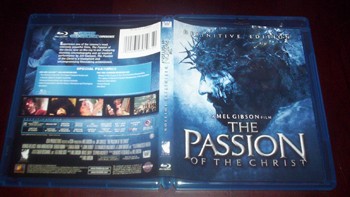 | 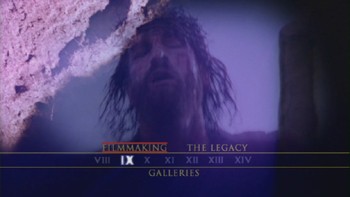 |
Video and Audio:
From the darkened moments in the garden to the massive walled-in architecture backdropping Jesus' trek to the crucifixion point, The Passion of the Christ looks extremely good in preserving the film's 2.40:1 negative in a sharp 1080p AVC encode. Detail operates as the crowning achievement in this transfer, as the sandy textures and ornate costume design all leap from the screen. Contrast levels display inky shadows and natural mid-tones, especially noticeable during the fire-lit nighttime sequences. Generally, the muted color palette shows off a pleasant gradient of tans and other dark varietals as well.
One troubling issue crops up with skin tone, however; now, I vaguely remember flesh tone being a bit on the pink-ish side in the theater, but nowhere near this hot. At times, they appear natural to the color scheme, while others step way too far over into blistering shades. No matter if it's Gibson's intent or not, the blistering rosy shades are too distracting in spots. Still, there are other scenes where facial tones and detail come across as perfectly natural and aptly displayed -- while staying distortion and edge-enhancement free. It's a stark, well-defined transfer from Fox that stands strong against a few nit-picky hiccups.
Special Features:
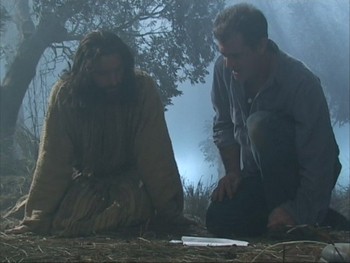 | 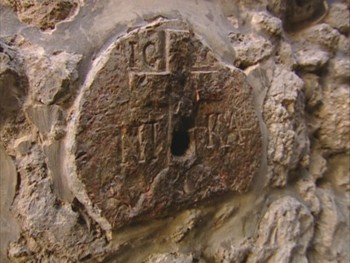 |
On the Blu-ray Disc itself, we've got four (!) Commentaries -- one with the filmmakers, one with the producers, one with theologians, and one (segmented) with the musical composer -- that give you just about every ounce of supplemental material that you could possibly want about the film's build quality and assembly. Gibson/Deschanel/Wright's commentary stays informative, though it takes an odd tone in being a more casual and chuckle-worthy filmmaker's discussion. The Producer's Commentary, however, is extremely smooth and informative, staying in pseudo-commoner speech as they discuss visual effects, make-up design, and other random anecdotes about shooting the film. Probably the best commentary, however, is the Theological Commentary, which gets Mel Gibson in the midst of religious experts as they discuss the symbolism, the potency, and the messages scattered throughout the film as they interconnect with the narrative of Christ. Don't let the fact that it's a "religion" commentary steer you away from it -- if that doesn't compel you -- because the symbolism that they discuss also pertains to Gibson's filmmaking techniques to convey messages.
Also available on this disc is the Passion: Recut version of the film which removes around 5 minutes of brutality form the picture, as well as a series of Footnotes that reference to the Biblical verses and historical accounts that the film's events use for quotations and "accuracy".
On the Standard Definition Disc Two, the material is separated into three portions: Filmmaking, The Legacy, and Galleries. Most of the special features are full-frame presentations, while a select few -- trailers and such -- have been enhanced for widescreen televisions. Most of them are fascinating, while others can grow to be a little repetitive as the features press forward. One factors is cleanly evident: these exasperating special features place heavy emphasis on this edition of The Passion of the Christ as the unequivocal "Definitive Edition".
In the Filmmaking portion, the key feature is the huge By His Wounds, We Are Healed: Making of The Passion of the Christ (1:40:16, FF) which follows just about every imaginable tangent, production element, and motivation behind Gibson's feature. The director is featured prominently through interview time and conversation during his shoots, giving anecdotes about script building, the accuracy of the production design and language, and his acting choices. It's exhaustive, but thankfully the feature has been segmented into twenty-one (21) chapters to allow for broken-up viewing times. Also in this section is an intriguing Panel Discussion (13:50, FF) that covers a Q&A on the production design. Finally, two Deleted Scenes (~4:30) are included.
In the Legacy portion, the history and symbolic representation of Jesus Christ are covered in a series of analytical featurettes. Through The Ages (11:57, FF) gives an study that bridges the gaps between art and religion, emphasized by art experts who take specific works and dive into the "symbiotic relationship" between the two. Some of the film's historical accuracy falls under focus in Paths of a Journey (9:24, FF), which gives a highly elaborative pathway through the "stations". It also connects them to their occurrences in the Bible, giving some historical insight into this trek. On Language (12:45) is a very insightful featurette that covers Gibson's usage of Jesus' traditional Aramaic language instead of English or any others in the eyes of the language expert on the film, while also covering how delving into that language gives the verbose a certain flow that would otherwise be lost. They've also brought on crucifixion experts to elaborate on the symbolic form of torture in the film in Crucifixion: Punishment in the Ancient World (17:27, FF), delving into the roots of the word "excruciating" while discussing the science behind the ghastly act. Rounding out this portion is Anno Domani (10:03, FF), a reference featurette that illustrates what happens to the disciples following the death of Christ.
In the Galleries portion, we're given a slew of static images to sift through pertaining to the conceptualization of the film. Production Art covers the extensive Costume and Set Design, Technical Drawings, and Storyboards (for Garden of Olives, The Flogging, Crucifixion FX, and Raising the Cross) associated with the film, while the Art Images reference the historical pieces of artwork referenced by the filmmakers in constructing the mood and aesthetic for the stations of the cross (Station I -- XIV). Historical Texts basically translates to the Bible verses referenced in the film, presented in lengthy fashion through a series of static, skippable lines of text. Characters and their Actors covers the many entities in the film, while giving filmographies and histories behind each actor that portrayed them. Also available are a fantastic series of Unit Photography stills, which offer a gorgeous array of black-and-white shots that capture Gibson's filmmaking process splendidly. Finally, we've got a series of Trailers and TV Spots, which the Trailers have both been enhanced for widescreen televisions.
Final Thoughts:
Few films have left me in a visceral daze after watching them, but The Passion of the Christ is undoubtedly one of them. How a film containing so much brutality and mean-spirited energy surrounding its focal character can be this reverent is astonishing, as Mel Gibson gathers together his award-winning directorial chops to piece together a "simple" work of art heavily saturated with symbolism and belief-bending rhetoric. While it's true that Christians will certainly walk away more affected by this than those of other beliefs (or lack thereof), the sheer strength in Christ's struggle to endure all shades of pain for belief can be soaked in by just about everyone. Plus, Mel Gibson can certainly tell a story, which he does amid beautiful photography and sweeping music. It's painful to watch -- at times very painful -- but The Passion of the Christ's message of perseverance is worth the anguish.
Fox's Blu-ray presentation of this "Definitive Edition" offers a striking visual transfer and immersive DTS HD Master Audio track, both of which pump the film full of tactile breadth. But the star of this show is the incredible array of supplements, which soars well beyond the levels of standard, condensed material that we see in most home video presentations. Though the return value is difficult to judge based on the skin-curdling content of the flogging, ridicule, and crucifixion of Jesus, it's still a marvelous picture to behold that comes Highly Recommended in this stellar, cost-effective presentation from Fox.
|
| Popular Reviews |
| Sponsored Links |
|
|
| Sponsored Links |
|
|
| Release List | Reviews | Shop | Newsletter | Forum | DVD Giveaways | Blu-Ray | Advertise |
|
Copyright 2024 DVDTalk.com All Rights Reserved. Legal Info, Privacy Policy, Terms of Use,
Manage Preferences,
Your Privacy Choices | |||||||









